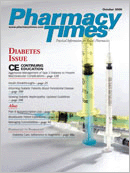Publication
Article
Pharmacy Times
Predicting the Magnitude of Drug Interactions: The Final Frontier
Prediction of potential drug-drug interactions has become increasingly accurate. Only limited advances have been made in the prediction of the magnitude of the interaction, however. Knowing the magnitude of an interaction and the therapeutic window of the object drug is very important in the assessment of risk to a patient. The change in the area under the concentration- time curve (AUC) of the object drug represents the single most important drug parameter. The AUC of drugs with narrow therapeutic windows (eg, warfarin) may need to change by only 20% to 30% to produce an adverse drug reaction. AUCs of drugs with wide therapeutic windows can often change by over 50% without changing patient response.
This column has discussed a number of variables known to affect the magnitude of change in the AUC of object drugs including the order of drug administration and a patient's genetic characteristics.1,2 The bioavailability of the object drug represents another important parameter. Bioavailability reflects the amount of a dose that reaches the systemic circulation and is often expressed as a percentage, with 100% representing complete absorption into the systemic circulation of the administered dose. Bioavailability can be altered in several ways, including drugs that bind the object drug in the gastrointestinal tract or drugs that change the presystemic metabolism of the object drug. When bioavailability is reduced by presystemic metabolism, inhibition of the pathway responsible will increase the bioavailability of the object drug and its AUC. Induction of presystemic metabolism will reduce both the object drug's bioavailability and AUC.
To examine the role of the degree of presystemic metabolism on drug interaction magnitude, one must consider interactions that only affect object drug firstpass metabolism but do not change its systemic metabolism. One example of this type of interaction would involve grapefruit juice, which appears to inhibit CYP3A4 located in the intestinal wall but does not appear to affect CYP3A4 in the liver. The Table summarizes the effect of grapefruit juice on a variety of drugs that are primarily metabolized by CYP3A4. It can be noted that until the bioavailability of the object drug falls below about 25%, the effect of grapefruit juice appears to be limited to less than a doubling of the object drug's plasma concentration. When the object drug bioavailability is less than 15% to 20%, however, very large increases in object drug concentrations can result from grapefruit juice coadministration.
Thus, drugs known to have a high degree of first-pass metabolism can be expected to demonstrate a greater change in their AUC when administered with a drug known to affect their metabolism. This will most often apply to drugs that are substrates for CYP3A4 because of the presence of this enzyme in the wall of the intestine and the liver. All of the drugs in the Table are primarily metabolized by CYP3A4. Interactions with grapefruit juice were chosen for this example to limit the CYP3A4 inhibition to a single site (intestinal wall). The dose of grapefruit juice was not the same in all of the examples, so variations are likely to be seen even when comparing drugs with similar bioavailability. For example, while high-dose grapefruit juice increases lovastatin concentrations by about 15-fold, low-dose grapefruit juice produces only about a 2-fold increase.3,4
Drs. Horn and Hansten are both professors of pharmacy at the University of Washington School of Pharmacy. For an electronic version of this article, including references if any, visit www.hanstenandhorn.com.
For a list of references, send a stamped, self-addressed envelope to: References Department, Attn. A. Rybovic, Pharmacy Times, Ascend Media Healthcare, 103 College Road East, Princeton, NJ 08540; or send an e-mail request to: [email protected]

Newsletter
Stay informed on drug updates, treatment guidelines, and pharmacy practice trends—subscribe to Pharmacy Times for weekly clinical insights.






